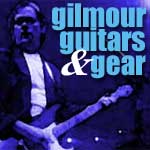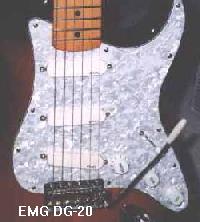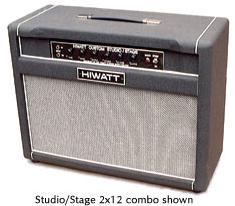


Gilmour, Guitars & Gear
Gilmour, Guitars & Gear
David Gilmour Endorsements

In this column, I'll be examining Pink Floyd guitarist David Gilmour's gear and playing techniques from a musician's point of view. Please feel free to e-mail me with questions and ideas for future articles at RichM66@Compuserve.com if you feel you have an idea that readers of Spare Bricks might find of interest. Past articles are now posted at http://richardmahon.8m.com/sbarchive.htm.
For years, Pink Floyd had a reputation based on their unwillingness to conform to the music business establishment. But times have changed, and in recent years band members have worked out endorsement deals on the equipment they use. For starters, simply listing the kind of equipment they use in their tour books is a form of an endorsement. How many people have purchased a Fender Stratocaster due to Gilmour's primary use of the guitar through the years?
EMG DG-20 Pro Series Pickup Set
Around 1985, Gilmour switched from vintage guitars with passive pickups to EMG battery powered active pickups. If you're looking for a tone from the classic Pink Floyd albums of the 1970s then a standard Stratocaster will do fine. But if you're looking for a tone similar to those achieved on the tour for A Momentary Lapse of Reason or the album and tour for The Division Bell then the EMG DG-20 setup could be right for you.
The EMG DG-20 setup comes complete with three SA single coil pickups, a five-way selector switch, master volume knob, EXG Guitar Expander circuit, and an SPC Presence Control circuit all mounted on a white pearl pickguard. A battery clip with a switching output jack is also included. A minimum amount of soldering (from the pickguard to the output jack) makes it easy to install.
 |
The combination of tones available in the DG-20 is almost endless. The EXG, located just below the volume knob, acts as a treble/bass boost. This shapes the signal in a "V" on a graphic equalizer, cutting the mids and raising the treble and bass portions of the signal. With this control set upwards of 6-10, it creates a crisp, clean, tone that you will mainly hear while Gilmour plays clean rhythm parts. "Brain Damage" is an excellent example. Through the main riff of the song, setting the EXG on a high setting through the main riff will give you a clean bright tone. The tone is thinner and cuts through the mix, adding clarity.
"Signs of Life" is another good example of the EXG at work. Here the EXG is set high, while the SPC is rolled back. In certain circumstances, it is possible to use the EXG to get a Telecaster type of sound. You can use the bridge pickup, set the EXG around 8 and the SPC around 2 and it will give you a somewhat "twangy" Telecaster sound while the addition of the SPC gives the signal a little boost. This works well on a song such as "Run Like Hell."
The SPC effectively cuts the treble and bass while raising the mid portion of the signal (like an inverted "V" on a graphic equalizer.) It will give a single coil pickup a warm, humbucker-like tone. Keeping the SPC on zero will yield a flat response. As you turn up the tone, you begin to notice the warm, rich tone associated with Gilmour's recent work. Take the song "Sorrow"; the SPC is on 10 when the opening riff is performed live. The SPC also boosts the signal, which can work well for any lead.
In essence, Gilmour uses the EXG to tighten up the tone for clarity and crispness for rhythms while the SPC is boosted to give a thicker tone for lead.
With the complexity of Gilmour's Pink Floyd performances, with extensive lighting and effects, the EMG setup eliminates unwanted buzz. The setup also drives the enormous number of pedals that Gilmour has at his disposal. This in itself is important, as there is no tone loss or signal degradation. In comparison, the signal on a standard Strat with passive pickups would probably seem flat and in need of a volume adjustment. There is no loss of signal or frequency drop off when the volume is turned down on the EMG set up, where you may get frequencies cut in the standard Strat set up. An excellent example would be the recent solo performances (Meltdown and the January shows in London & Paris). Gilmour used guitars without EMG pickups, and the tone was good, but it lacked the punch and presence that you come to expect from a Pink Floyd performance. The Delicate Sound Of Thunder and Pulse releases provide excellent examples of Gilmour's EMG setup at work.
Hiwatt: Signature David Gilmour
 |
The Hiwatt amplifier company in the U.K. recently started distribution of the Signature David Gilmour model. While it is based on an early 1970s DR-103 100-watt amp head, it has a modification Gilmour started to use in the mid-70s. Early versions of the Hiwatt DR-103 have 4 inputs: 2 Normal and 2 Brilliant. Gilmour had one of each inputs wired together that would allow him to create a mix between the two sounds. This modification is built into the Signature David
Gilmour model.
Hiwatt's Research and Development department continues to work on a design for a David Gilmour Hiwatt combo amp. This would be modeled after the pair of Hiwatt SA-212s that Gilmour used while recording The Division Bell. 100 watts of power would be combined with 2 12-inch Fane speakers (Fane speakers were used in Hiwatt & WEM speaker cabinets). Gilmour also prefers to use his Hiwatt SA-212s with Fender Tweed (original & re-issue) amps for projects outside of Pink Floyd.